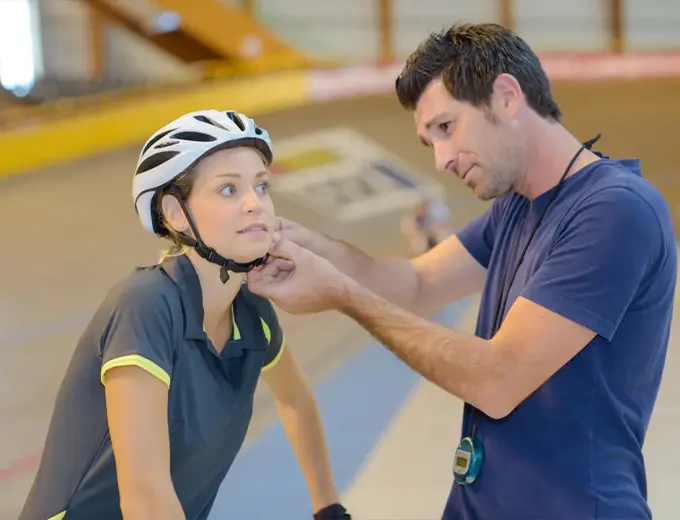Traumatic brain injuries (TBIs) can occur due to a multitude of causes beyond sports-related incidents, encompassing motor vehicle accidents, falls, workplace injuries, assaults, and various other scenarios. Among these, motor vehicle accidents stand as a significant contributor to TBI cases worldwide. The high speeds involved in car crashes can subject individuals to tremendous forces upon impact, leading to sudden acceleration or deceleration forces that can result in severe head injuries. Even seemingly minor collisions can cause TBIs due to the abrupt movement of the brain within the skull, potentially causing contusions, concussions, or more severe forms of brain trauma.
Sports Related Brain Injuries
Sports-related traumatic brain injuries (TBIs) can arise from various factors and mechanisms during athletic engagements. Activities characterized by high-impact collisions, such as football, rugby, hockey, and boxing, inherently harbor an increased risk for TBIs owing to frequent contact, falls, and equipment interactions. Direct blows to the head from tackles, collisions, or physical strikes can lead to concussions or more severe TBIs.
Moreover, rotational forces incurred during sudden shifts in direction or rapid accelerations can induce the brain to twist or rotate within the skull, causing diffuse axonal injuries and other forms of TBI. Even seemingly innocuous incidents, like a forceful impact to the body resulting in swift deceleration of the head, can precipitate significant brain trauma. Further complicating matters, suboptimal technique, inadequate protective equipment, and insufficient medical oversight can exacerbate the risk of sports-related TBIs. Thus, a confluence of factors, including sport dynamics, player conduct, and environmental variables, collectively underpins the occurrence of TBIs in athletic pursuits.


Brain Injury Caused by Slip and Falls
Traumatic brain injuries (TBIs) resulting from slip and fall accidents are influenced by various factors and mechanisms inherent in such incidents. Whether indoors or outdoors, surfaces may become slippery due to spills, precipitation, or inadequate maintenance, increasing the risk of falls. Individuals may lose their footing on uneven terrain, slippery floors, or poorly maintained walkways, leading to sudden impacts to the head. The force of the fall can cause the brain to strike against the skull, resulting in concussions or more severe TBIs. Moreover, the angle and speed of the fall can contribute to rotational forces, exacerbating brain trauma.
Factors such as poor lighting, obstacles, and footwear choices further heighten the risk of slips and falls. Even seemingly minor falls can have serious consequences, particularly for older adults or individuals with pre-existing medical conditions. Thus, slip and fall accidents represent a multifaceted risk for TBIs, influenced by environmental conditions, individual factors, and preventive measures.
Brain Injury Caused by Motor Vehicle Collisions
Traumatic brain injuries resulting from motor vehicle collisions are influenced by a myriad of factors inherent in such accidents. The high speeds involved in many collisions amplify the force of impact, increasing the likelihood of severe head injuries. However, it’s important to note that even minor accidents at low speeds can cause brain injury. Direct blows to the head from the steering wheel, dashboard, or other vehicle components can result in concussions or severe TBIs. The sudden deceleration or acceleration experienced during a collision can cause the brain to jolt within the skull, leading to diffuse axonal injuries and other forms of TBI. Even with the implementation of safety features such as airbags and seat belts, occupants may still sustain head injuries due to the complex dynamics of crashes. Factors such as seat position, vehicle type, and road conditions further contribute to the risk of TBIs in motor vehicle collisions. The presence of alcohol, distraction, or fatigue can exacerbate the severity of injuries. Motor vehicle collisions represent a significant risk for TBIs, underscored by the interplay of various factors including vehicle dynamics, occupant behavior, and safety measures.


Non-Traumatic Brain Injury
Traumatic brain injuries caused by non-traumatic events encompass a range of factors and scenarios distinct from those involving physical trauma. These injuries often result from internal processes such as strokes, tumors, infections, or metabolic disorders affecting the brain’s function. Strokes, caused by disruptions in blood flow to the brain, can lead to oxygen deprivation and tissue damage, resulting in brain injury. Similarly, tumors pressing on brain tissue can cause structural damage and impair neurological function. Infections such as meningitis or encephalitis can also lead to inflammation and damage to brain tissue. Metabolic disorders affecting brain chemistry, such as severe electrolyte imbalances or hypoglycemia, can result in neurological dysfunction and brain injury. Unlike traumatic TBIs, non-traumatic injuries may develop gradually over time and lack an external cause. Factors such as age, genetics, and lifestyle choices can influence the risk of non-traumatic TBIs. Prompt diagnosis and treatment are crucial for managing these conditions and minimizing long-term neurological consequences.
